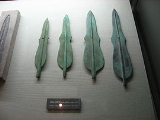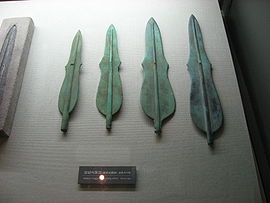
Liaoning bronze dagger culture
Encyclopedia
The Liaoning bronze dagger culture is an archeological complex of the late Bronze Age
in Korea and China. Artifacts from the culture are found primarily in the Liaoning
area of Manchuria
and in the Korean peninsula
. Various other bronze artifacts, including ornaments and weapons, are associated with the culture, but the daggers are viewed as the most characteristic. Liaoning bronzes contain a higher percentage of zinc than those of the neighboring bronze cultures.
Lee Chung-kyu(1996) considers that the culture is properly divided into five phases: Phases I and II typified by violin-shaped daggers, Phases IV and V by slender daggers, and Phase III by the transition between the two. Of these, remains from Phases I, II and III can be found in some amounts in both the Korean peninsula and Manchuria, but remains from Phases IV and V are found almost exclusively in Korea.
 The early phase consists of an early period of bronze manufacture without daggers, followed by a period of producing violin-shaped daggers. The prime period of production of violin-shaped daggers is dated to the 8th and 7th centuries BCE.
The early phase consists of an early period of bronze manufacture without daggers, followed by a period of producing violin-shaped daggers. The prime period of production of violin-shaped daggers is dated to the 8th and 7th centuries BCE.
The earliest artifacts from this period are found exclusively in Manchuria, and seem only gradually to have spread to the Korean peninsula. By Lee's (1996) Phase II, however, a distinctive notched form of dagger begins to emerge in southern Korea, suggesting that by this time independent bronze production had begun in that region.
Evidence gained from pottery indicates that the bronze dagger "culture" of this time actually included several distinct cultural groups. One distinct pottery tradition is found in Manchuria and northwestern Korea, another in the Taedong River
valley, another in the southwest around the Chungcheong
provinces including the Geum River, and yet another throughout the rest of the southern Korean peninsula including Jeju island
.
The greatest concentration of bronze daggers is found in the Geum River
valley of South Chungcheong province. Away from this area, the daggers become progressively fewer. This appears to indicate that most daggers were produced in the Geum valley, and the other cultures of the peninsula acquired them primarily by trade. Trade also took place by sea, with artifacts from the Later Phase found in Japan
ese archeological sites as well.
Lee (1996) divides this phase into two distinct sections: one dating to the 3rd century BCE in which the production of slender bronze daggers predominated, and one dating to the 2nd century BCE in which daggers are often accompanied by bronze mirrors with geometric designs and halberds influenced by the Chinese Qin state
. In the first part, a single pottery culture typified by clay-band applique is found throughout the Korean peninsula, but in the second part distinctive pottery types emerge in the northwest and the remainder of the peninsula.
, which occasionally enters Chinese annals as a contemporary of Wiman Joseon
. Lee (1984, p. 13) views this as the period of emergence of the "walled-town states" in Korean culture, a hierarchical political structure in contrast to the tribal system which had prevailed during the Neolithic
period.
Bronze Age
The Bronze Age is a period characterized by the use of copper and its alloy bronze as the chief hard materials in the manufacture of some implements and weapons. Chronologically, it stands between the Stone Age and Iron Age...
in Korea and China. Artifacts from the culture are found primarily in the Liaoning
Liaoning
' is a province of the People's Republic of China, located in the northeast of the country. Its one-character abbreviation is "辽" , a name taken from the Liao River that flows through the province. "Níng" means "peace"...
area of Manchuria
Manchuria
Manchuria is a historical name given to a large geographic region in northeast Asia. Depending on the definition of its extent, Manchuria usually falls entirely within the People's Republic of China, or is sometimes divided between China and Russia. The region is commonly referred to as Northeast...
and in the Korean peninsula
Korean Peninsula
The Korean Peninsula is a peninsula in East Asia. It extends southwards for about 684 miles from continental Asia into the Pacific Ocean and is surrounded by the Sea of Japan to the south, and the Yellow Sea to the west, the Korea Strait connecting the first two bodies of water.Until the end of...
. Various other bronze artifacts, including ornaments and weapons, are associated with the culture, but the daggers are viewed as the most characteristic. Liaoning bronzes contain a higher percentage of zinc than those of the neighboring bronze cultures.
Lee Chung-kyu(1996) considers that the culture is properly divided into five phases: Phases I and II typified by violin-shaped daggers, Phases IV and V by slender daggers, and Phase III by the transition between the two. Of these, remains from Phases I, II and III can be found in some amounts in both the Korean peninsula and Manchuria, but remains from Phases IV and V are found almost exclusively in Korea.
Violin-shaped daggers

The earliest artifacts from this period are found exclusively in Manchuria, and seem only gradually to have spread to the Korean peninsula. By Lee's (1996) Phase II, however, a distinctive notched form of dagger begins to emerge in southern Korea, suggesting that by this time independent bronze production had begun in that region.
Evidence gained from pottery indicates that the bronze dagger "culture" of this time actually included several distinct cultural groups. One distinct pottery tradition is found in Manchuria and northwestern Korea, another in the Taedong River
Taedong River
The Taedong River is a large river in North Korea. It rises in the Rangrim Mountains of the country's north. It then flows southwest into Korea Bay at Namp'o. In between, it runs through the country's capital, Pyongyang. Along the river are landmarks such as the Juche Tower and Kim Il-sung...
valley, another in the southwest around the Chungcheong
Chungcheong
Chungcheong was one of the eight provinces of Korea during the Joseon Dynasty. Chungcheong was located in the southwest of Korea...
provinces including the Geum River, and yet another throughout the rest of the southern Korean peninsula including Jeju island
Jeju-do
Jeju-do is the only special autonomous province of South Korea, situated on and coterminous with the country's largest island. Jeju-do lies in the Korea Strait, southwest of Jeollanam-do Province, of which it was a part before it became a separate province in 1946...
.
Slender daggers
This later part of the Liaoning bronze dagger culture is often referred to as the "Korean bronze dagger culture," since it was largely restricted to the Korean peninsula. At this point the Liaoning culture artifacts begin to disappear from the Manchurian area. A new form of dagger begins to turn up on the Korean peninsula, straight and slender.The greatest concentration of bronze daggers is found in the Geum River
Geum River
The Geum-gang River is located in South Korea. It is a major river that originates in Jangsu-eub, North Jeolla Province. It flows northward through North Jeolla and North Chungcheong Provinces and then changes direction in the vicinity of Greater Daejeon and flows southwest through South...
valley of South Chungcheong province. Away from this area, the daggers become progressively fewer. This appears to indicate that most daggers were produced in the Geum valley, and the other cultures of the peninsula acquired them primarily by trade. Trade also took place by sea, with artifacts from the Later Phase found in Japan
Japan
Japan is an island nation in East Asia. Located in the Pacific Ocean, it lies to the east of the Sea of Japan, China, North Korea, South Korea and Russia, stretching from the Sea of Okhotsk in the north to the East China Sea and Taiwan in the south...
ese archeological sites as well.
Lee (1996) divides this phase into two distinct sections: one dating to the 3rd century BCE in which the production of slender bronze daggers predominated, and one dating to the 2nd century BCE in which daggers are often accompanied by bronze mirrors with geometric designs and halberds influenced by the Chinese Qin state
Qin (state)
The State of Qin was a Chinese feudal state that existed during the Spring and Autumn and Warring States Periods of Chinese history...
. In the first part, a single pottery culture typified by clay-band applique is found throughout the Korean peninsula, but in the second part distinctive pottery types emerge in the northwest and the remainder of the peninsula.
Historical identity
The disappearance of the Liaoning bronze dagger culture from Manchuria appears to coincide with the State of Yan's conquest of that area. The Korean bronze dagger culture of the Later Phase appears to correspond with the state of JinJin (Korean history)
Jin state was an early Korean, Iron Age state which occupied some portion of the southern Korean peninsula during the 2nd and 3rd centuries BC, bordering the Korean kingdom Gojoseon to the north. Its capital was somewhere south of the Han River...
, which occasionally enters Chinese annals as a contemporary of Wiman Joseon
Wiman Joseon
Wiman Joseon was part of the Gojoseon period of Korean history. It began with Wiman's seizure of the throne from Gojoseon's King Jun and ended with the death of King Ugeo who was a grandson of Wiman.-Founding:...
. Lee (1984, p. 13) views this as the period of emergence of the "walled-town states" in Korean culture, a hierarchical political structure in contrast to the tribal system which had prevailed during the Neolithic
Neolithic
The Neolithic Age, Era, or Period, or New Stone Age, was a period in the development of human technology, beginning about 9500 BC in some parts of the Middle East, and later in other parts of the world. It is traditionally considered as the last part of the Stone Age...
period.
See also
- List of China-related topics
- List of Korea-related topics
- History of KoreaHistory of KoreaThe Korean Peninsula was inhabited from the Lower Paleolithic about 400,000-500,000 years ago. Archeological evidence indicates that the presence of modern humans in northeast Asia dates to 39,000 years ago. The earliest known Korean pottery dates to around 8000 BC, and the Neolithic period began...
- Megalithic tomb

